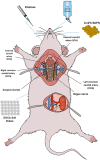Current Mouse Models of Intracranial Aneurysms: Analysis of Pharmacological Agents Used to Induce Aneurysms and Their Impact on Translational Research
- PMID: 38258667
- PMCID: PMC11056163
- DOI: 10.1161/JAHA.123.031811
Current Mouse Models of Intracranial Aneurysms: Analysis of Pharmacological Agents Used to Induce Aneurysms and Their Impact on Translational Research
Abstract
Intracranial aneurysms (IAs) are rare vascular lesions that are more frequently found in women. The pathophysiology behind the formation and growth of IAs is complex. Hence, to date, no single pharmacological option exists to treat them. Animal models, especially mouse models, represent a valuable tool to explore such complex scientific questions. Genetic modification in a mouse model of IAs, including deletion or overexpression of a particular gene, provides an excellent means for examining basic mechanisms behind disease pathophysiology and developing novel pharmacological approaches. All existing animal models need some pharmacological treatments, surgical interventions, or both to develop IAs, which is different from the spontaneous and natural development of aneurysms under the influence of the classical risk factors. The benefit of such animal models is the development of IAs in a limited time. However, clinical translation of the results is often challenging because of the artificial course of IA development and growth. Here, we summarize the continuous improvement in mouse models of IAs. Moreover, we discuss the pros and cons of existing mouse models of IAs and highlight the main translational roadblocks and how to improve them to increase the success of translational IA research.
Keywords: artery ligation; hypertension; intracranial aneurysm; mouse models; pharmacological treatments.
Figures


Similar articles
-
Unruptured intracranial aneurysms in the Familial Intracranial Aneurysm and International Study of Unruptured Intracranial Aneurysms cohorts: differences in multiplicity and location.J Neurosurg. 2012 Jul;117(1):60-4. doi: 10.3171/2012.4.JNS111822. Epub 2012 Apr 27. J Neurosurg. 2012. PMID: 22540404 Free PMC article.
-
Rupture risk of intracranial aneurysms: Comparison between small ruptured intracranial aneurysms and large unruptured intracranial aneurysms.Medicine (Baltimore). 2024 Jul 12;103(28):e38909. doi: 10.1097/MD.0000000000038909. Medicine (Baltimore). 2024. PMID: 38996146 Free PMC article.
-
Genetic factors involves in intracranial aneurysms--actualities.J Med Life. 2015 Jul-Sep;8(3):336-41. J Med Life. 2015. PMID: 26351537 Free PMC article. Review.
-
[Current Knowledge on the Genetic Analysis and Development of Medical Therapy for Intracranial Aneurysms].No Shinkei Geka. 2022 Jan;50(1):179-195. doi: 10.11477/mf.1436204543. No Shinkei Geka. 2022. PMID: 35169098 Japanese.
-
Endogenous animal models of intracranial aneurysm development: a review.Neurosurg Rev. 2021 Oct;44(5):2545-2570. doi: 10.1007/s10143-021-01481-w. Epub 2021 Jan 26. Neurosurg Rev. 2021. PMID: 33501561 Free PMC article. Review.
Cited by
-
Tobacco smoke condensate-induced senescence in endothelial cells was ameliorated by colchicine treatment via suppression of NF-κB and MAPKs P38 and ERK pathways activation.Cell Commun Signal. 2024 Apr 3;22(1):214. doi: 10.1186/s12964-024-01594-x. Cell Commun Signal. 2024. PMID: 38570838 Free PMC article.
-
Dimethyl Fumarate Mediates Sustained Vascular Smooth Muscle Cell Remodeling in a Mouse Model of Cerebral Aneurysm.Antioxidants (Basel). 2024 Jun 27;13(7):773. doi: 10.3390/antiox13070773. Antioxidants (Basel). 2024. PMID: 39061841 Free PMC article.
-
Neutrophils extracellular traps myeloperoxidase and elastase predict cerebral vasospasms after aneurysmal subarachnoid hemorrhage.Heliyon. 2024 Nov 20;10(23):e40562. doi: 10.1016/j.heliyon.2024.e40562. eCollection 2024 Dec 15. Heliyon. 2024. PMID: 39654759 Free PMC article.
-
A modified surgical approach to induce circle Willis perforation in mice using the common carotid artery.Sci Rep. 2025 Apr 21;15(1):13769. doi: 10.1038/s41598-025-97603-1. Sci Rep. 2025. PMID: 40258902 Free PMC article.
-
Modified Intracranial Aneurysm Rupture Rat Model with Angiographic Imaging.Transl Stroke Res. 2025 Jul 16. doi: 10.1007/s12975-025-01366-w. Online ahead of print. Transl Stroke Res. 2025. PMID: 40670870
References
-
- Etminan N, Chang HS, Hackenberg K, de Rooij NK, Vergouwen MDI, Rinkel GJE, Algra A. Worldwide incidence of aneurysmal subarachnoid hemorrhage according to region, time period, blood pressure, and smoking prevalence in the population: a systematic review and meta‐analysis. JAMA Neurol. 2019;76:588–597. doi: 10.1001/jamaneurol.2019.0006 - DOI - PMC - PubMed
Publication types
MeSH terms
Grants and funding
LinkOut - more resources
Full Text Sources
Medical
Miscellaneous

